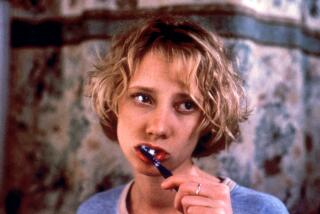Signe Hasso, 91; Swede Acted for Leading Movie Directors
Signe Hasso, a Swedish-born stage and film actress who played strong leading ladies in American movies in the 1940s, most notably in George Cukorâs âA Double Life,â has died. She was 91.
Hasso died Friday at Cedars-Sinai Medical Center in Los Angeles. The cause of death was not announced.
For the record:
12:00 a.m. June 10, 2002 For The Record
Los Angeles Times Monday June 10, 2002 Home Edition Main News Part A Page 2 National Desk 1 inches; 56 words Type of Material: Correction
Hasso obituary--An obituary of actress Signe Hasso in Sundayâs Times incorrectly stated her age. She was 86.
Her father and grandfather died when she was 4, and her mother supported the family by making waffles. Hasso lived with her mother, grandmother, sister and brother in a one-room apartment in Stockholm.
At 12, she fell into acting work somewhat by accident.
âA playmate of mine who used to act took ill. She was the niece of a stage manager, and so he asked her if she knew of any other little girl who could act, and she gave him my name,â she told the Swedish Press.
âI was 12 then and didnât want to go and neither did my sister, so my mother flipped a coin. I lost,â she said. âMy mother promised me an orange if I would go. They were very rare in those days. And so, with an orange in my pocket, I went to the Royal Dramatic Theater.â
Her audition for the role in a Moliere play was a success. She started earning a living as an actress and, despite her familyâs economic situation, was able to attend one of the better schools in Stockholm.
At 16 she was back at the Royal Dramatic Theater as a student--the youngest acting pupil in its history. By age 19 she was married and had a baby.
Hasso found work in Swedish films and in theater throughout Scandinavia.
She came to Hollywood in 1940 and signed a contract with RKO, but few acting roles materialized.
As she later said, she was nearly out on the street when she decided to go to New York, where she found work in the theater.
Toward the end of World War II, she returned to Hollywood and signed a contract with MGM. Over the next few years Hasso worked with some of the industryâs leading directors.
She made Fred Zinnemannâs âThe Seventh Crossâ with Spencer Tracy, Cecil B. DeMilleâs âThe Story of Dr. Wassellâ with Gary Cooper, Henry Hathawayâs âThe House on 92nd Streetâ with Lloyd Nolan, and Richard Brooksâ first movie as a director, âCrisis,â with Cary Grant.
But her favorite and the movie that critics apparently liked best was 1947âs âA Double Life.â It starred Ronald Colman as an actor so immersed in playing Othello that his stage character takes possession of his off-screen personality. Hasso played his wife, and Colman won the best actor Academy Award for his performance.
After the death of her son in a car accident in 1957, Hasso returned to Scandinavia to work in theater and movies.
Much of the rest of her American career was spent in character roles on television, including the miniseries âQB VIIâ and the movie âEvita Peron.â
A writer and lyricist, Hasso made perhaps her final TV appearance last year in a documentary on her legendary friend and countrywoman, actress Greta Garbo.
Information on survivors was not immediately available.
*
Times staff writer Susan King contributed to this report.
More to Read
Only good movies
Get the Indie Focus newsletter, Mark Olsen's weekly guide to the world of cinema.
You may occasionally receive promotional content from the Los Angeles Times.










